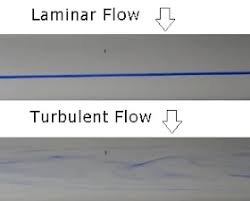Reynolds Number and Its Significance in Purified Water System

Reynolds Number and Its Significance in Purified Water System
1. What is Reynolds Number?
-
Reynolds number (Re) is a dimensionless number that predicts the flow regime of a fluid (laminar, transitional, or turbulent).
-
Formula:
Where:
-
ρ = Fluid density (kg/m³)
-
v = Velocity of fluid (m/s)
-
D = Pipe diameter (m)
-
μ = Dynamic viscosity of fluid (Pa·s)
2. Flow Regimes
-
Laminar flow (Re < 2000): Fluid moves in parallel layers with little mixing.
-
Turbulent flow (Re > 4000): Fluid has chaotic mixing and uniform velocity profile.
-
Transitional flow (2000 < Re < 4000): Unstable zone between laminar and turbulent.
3. Significance in Purified Water Systems
-
Microbial Control
-
Turbulent flow (Re > 4000) ensures proper mixing and minimizes biofilm formation on inner pipe surfaces.
-
Laminar flow allows stagnation zones where microorganisms can attach and multiply.
-
-
System Design
-
PW and WFI distribution loops are designed to maintain turbulent flow velocity ≥ 1.0–1.5 m/s (depending on pipe diameter).
-
Ensures effective scouring action of water against pipe walls.
-
-
Validation & Qualification
-
During system qualification, Reynolds number calculations confirm that piping design and pumps maintain turbulent flow.
-
Regulatory agencies (FDA, EMA, WHO) expect turbulent conditions to ensure microbiological quality.
-
-
Operational Monitoring
-
Continuous monitoring of flow velocity and return flow ensures system stays within design limits.
-
Helps in early detection of flow disruptions or pump failures.
-
4. Practical Example
-
Suppose purified water (ρ ≈ 1000 kg/m³, μ ≈ 0.001 Pa·s) flows at 1.2 m/s in a pipe of 0.05 m diameter:
Re=0.0011000×1.2×0.05=60,000
→ This indicates turbulent flow (well above 4000), ensuring microbial control.
✅ In short:
Reynolds Number helps determine whether purified water in distribution loops flows turbulently, which is essential for preventing biofilm formation, ensuring microbial control, and complying with GMP design standards.
🎓 Discover one of the best Pharmaceutical Microbiology course available —click below to explore the course that’s shaping future Microbiology course skills.

